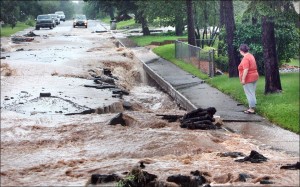America’s older suburbs may face an infrastructure crisis from the last place they expect — aging storm water management systems.
In a presentation at the annual LOCUS conference in Washington, D.C., this morning, Ellen Dunham-Jones, author of “Retrofitting Suburbia,” listed a number of factors driving the re-development of America’s suburbs. They include the usual suspects such as energy-efficiency, emancipation from auto dependency and housing affordability as well as some less commonly recognized trends such as the aging of the population and public health. But the one that took me by surprise was water.
“Water is the next oil,” said Dunham-Jones, a Georgia Institute of Technology professor. By that, I understood her to mean that clean water is the next object of resource scarcity, especially in western communities where much of the waste water is, well… wasted.
Water issues also have dogged America’s older cities where waste-water and storm-water infrastructure built a century ago first began to decay. But the problems are spreading to suburban jurisdictions developed since World War II, Dunham-Jones said. The early suburbs were built with little thought to water issues. Many developments were built in flood plains or wetlands. Streams were funneled through storm culverts. Engineered, hard-infrastructure solutions that may have been adequate back then have proven less so as development spread and watersheds were paved over with impermeable surfaces, she explained.
Add to that the fact that some older pipes and culverts are crumbling and that warmer climate is associated with more extreme weather events, and the suburbs could have a time bomb on their hands — one they don’t even hear ticking.
— JAB



